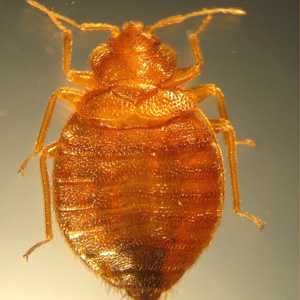
Case #219 - January, 2008
Five hunters spent a weekend in a cabin in the Northeastern United States. One of the hunters, who slept in a sleeping bag on the floor of the cabin, awoke in the morning with a rash on various parts of his body (Figure A). Because the area was endemic for Lyme disease, public health officials wanted to search for the tick vector. Arthropods (Figures B and C) found under a rug in the cabin were collected and sent to the state public health laboratory for identification. What is your diagnosis? Based on what criteria?



Case Answer
This was a case of bed bug infestation caused by Cimex lectularius (Insecta: Hemiptera: Cimicidae). Diagnostic features were:
- an almost round, flattened body, with lateral expansions on the prothorax, prominent compound eyes, and lack of functional wings.
- piercing-sucking mouthparts characteristic of the true bugs in the order Hemiptera (Figure C).
- antennae (Figures B and C) and wing pads (black arrow, Figure B); these are features of insects and arachnids (i.e., ticks) do not possess these structures.

Figure B
There are several species in the genus Cimex. The two most common species that feed on humans are C. lectularius and C. hemipterus, the latter of which is more common in tropical parts of the world. Bed bugs are nocturnal blood-sucking ectoparasites. By day, they usually hide in cracks, crevices, or under mattresses and rugs, etc. Humans are frequently bitten during the night as they sleep. Although bed bugs have been found naturally infected with a variety of bloodborne pathogens, they are not considered effective vectors for disease. The primary medical concern is the inflammatory response to their bites.
More on: Bed Bugs
These images were kindly contributed by Dr. Harold Harlan and the Armed Forces Pest Management Board.
Images presented in the monthly case studies are from specimens submitted for diagnosis or archiving. On rare occasions, clinical histories given may be partly fictitious.
DPDx is an education resource designed for health professionals and laboratory scientists. For an overview including prevention and control visit www.cdc.gov/parasites/.
- Page last reviewed: August 24, 2016
- Page last updated: August 24, 2016
- Content source:
- Global Health – Division of Parasitic Diseases and Malaria
- Notice: Linking to a non-federal site does not constitute an endorsement by HHS, CDC or any of its employees of the sponsors or the information and products presented on the site.
- Maintained By:


 ShareCompartir
ShareCompartir